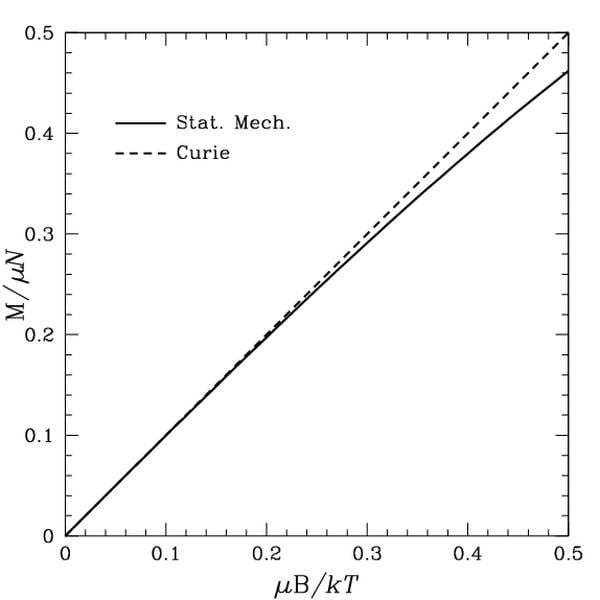 | ||
In a paramagnetic material the magnetization of the material is (approximately) directly proportional to an applied magnetic field. However, if the material is heated, this proportionality is reduced: for a fixed value of the field, the magnetization is (approximately) inversely proportional to temperature. This fact is encapsulated by Curie's law:
Contents
- Derivation with quantum mechanics
- Two state spin 12 particles
- General case
- Derivation with classical statistical mechanics
- References
where
This relation was discovered experimentally (by fitting the results to a correctly guessed model) by Pierre Curie. It only holds for high temperatures, or weak magnetic fields. As the derivations below show, the magnetization saturates in the opposite limit of low temperatures, or strong fields.
Derivation with quantum mechanics
A simple model of a paramagnet concentrates on the particles which compose it which do not interact with each other. Each particle has a magnetic moment given by
Two-state (spin-1/2) particles
To simplify the calculation, we are going to work with a 2-state particle: it may either align its magnetic moment with the magnetic field, or against it. So the only possible values of magnetic moment are then
and
When one seeks the magnetization of a paramagnet, one is interested in the likelihood of a particle to align itself with the field. In other words, one seeks the expectation value of the magnetization
where the probability of a configuration is given by its Boltzmann factor, and the partition function
Therefore, in this simple case we have:
This is magnetization of one particle, the total magnetization of the solid is given by
The formula above is known as the Langevin paramagnetic equation. Pierre Curie found an approximation to this law which applies to the relatively high temperatures and low magnetic fields used in his experiments. Let's see what happens to the magnetization as we specialize it to large
this is sometimes called the Curie regime. We also know that if
so
with a Curie constant given by
In the regime of low temperatures or high fields,
General case
When the particles have an arbitrary spin (any number of spin states), the formula is a bit more complicated. At low magnetic fields or high temperature, the spin follows Curie's law, with
where
For this more general formula and its derivation (including high field, low temperature) see the article: Brillouin function. As the spin approaches infinity, the formula for the magnetization approaches the classical value derived in the following section.
Derivation with classical statistical mechanics
An alternative treatment applies when the paramagnetons are imagined to be classical, freely-rotating magnetic moments. In this case, their position will be determined by their angles in spherical coordinates, and the energy for one of them will be:
where
We see there is no dependence on the
Now, the expected value of the
To simplify the calculation, we see this can be written as a differentiation of
(This approach can also be used for the model above, but the calculation was so simple this is not so helpful.)
Carrying out the derivation we find
where
This function would appear to be singular for small
